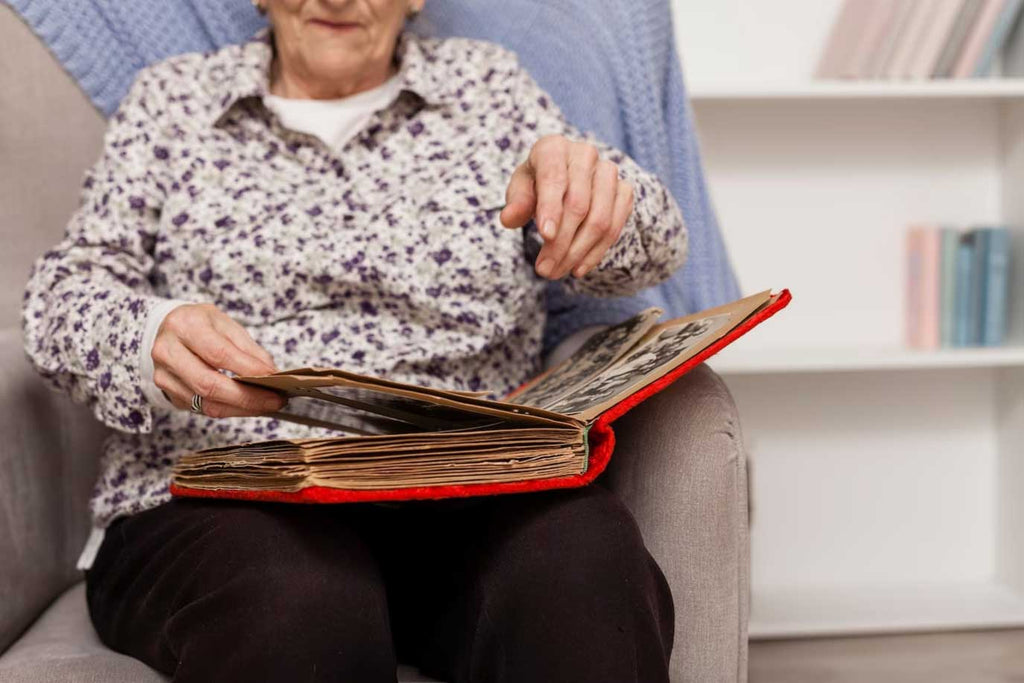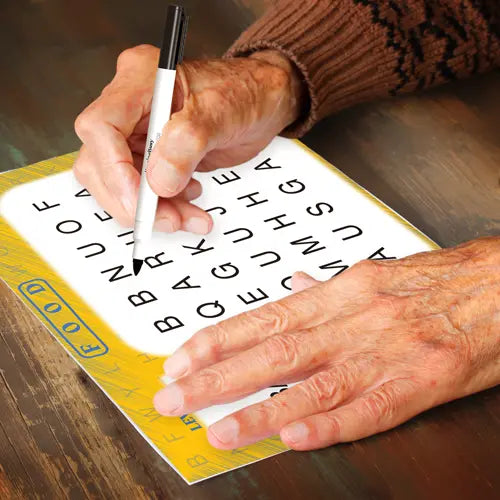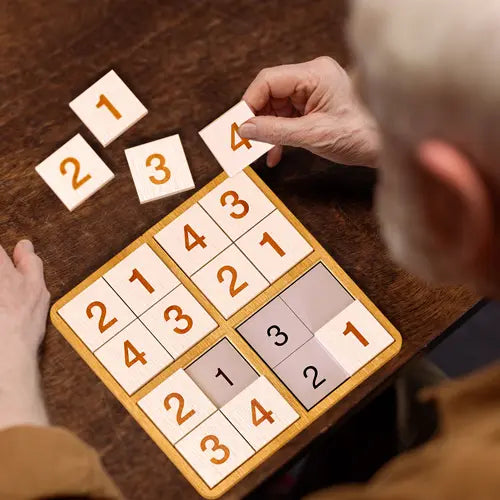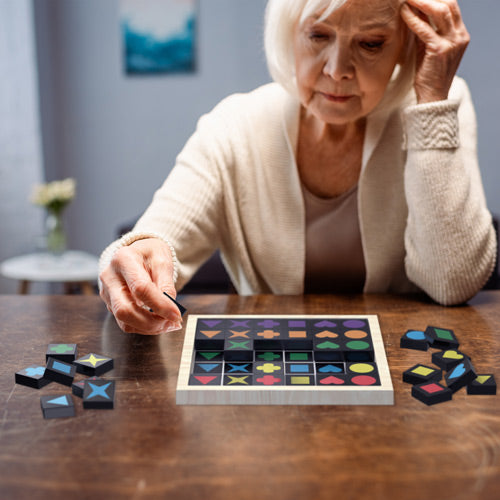
Caring for a loved one with dementia can be a challenging and emotional experience. As dementia progresses, it can become more difficult for your loved one to engage in activities they once enjoyed. However, there are still many activities you can do with your loved one that can provide a sense of purpose and enjoyment.
Sorting Activities for Dementia Patients
Sorting activities are a great way to engage your loved one's mind and help them feel accomplished. Here are seven sorting activities for dementia patients that you can do together.
1. Sorting by Color
Sorting objects by color is a simple and effective activity that can be engaging for dementia patients. Not only does it provide a sense of accomplishment and satisfaction, but it can also help improve cognitive skills such as visual perception, problem-solving, and concentration.
To get started with sorting by color, you can use a variety of objects such as beads, buttons, or even socks. Choose two or three colors to begin with and gradually increase the number of colors as your loved one becomes more comfortable with the activity. You can also use pictures or photographs of everyday objects that are sorted by color.
To make the activity more challenging, try using shades or hues of the same color. For example, you could sort blue objects into light blue, medium blue, and dark blue categories. This can help stimulate visual perception and improve concentration.
Encourage your loved one to describe the colors they are working with and talk about what they are sorting. This can help promote communication and socialization between caregiver and patient. Remember to be patient and supportive, and adjust the difficulty level based on your loved one's abilities and interests.
Sorting by color is a fun and beneficial activity that can help improve cognitive function and promote social interaction for dementia patients.
2. Sorting by Shape
Sorting objects by shape is another beneficial activity for dementia patients that can help improve cognitive skills such as visual perception, problem-solving, and concentration. It can also provide a sense of accomplishment and satisfaction for the patient.
To get started with sorting by shape, you can use a variety of objects such as blocks, puzzle pieces, or even kitchen utensils. Choose two or three shapes to begin with and gradually increase the number of shapes as your loved one becomes more comfortable with the activity. You can also use pictures or photographs of everyday objects that are sorted by shape.
To make the activity more challenging, try using shapes that are similar but not identical. For example, you could sort objects into circles, ovals, and ellipses categories. This can help stimulate problem-solving and improve visual perception.
Sorting by shape is a fun and beneficial activity that can help improve cognitive function and promote social interaction for dementia patients.
3. Sorting by Size
Sorting objects by size is another engaging activity that can help improve cognitive skills such as spatial awareness and problem-solving. It can also provide a sense of accomplishment and satisfaction for dementia patients.
To get started with sorting by size, you can use a variety of objects such as shells, rocks, or even buttons. Choose two or three sizes to begin with and gradually increase the number of sizes as your loved one becomes more comfortable with the activity. You can also use pictures or photographs of everyday objects that are sorted by size.
To make the activity more challenging, try using objects that are similar in size but not identical. For example, you could sort objects into small, medium, and large categories based on subtle differences in size. This can help stimulate problem-solving and improve spatial awareness.
4. Sorting by Category
Sorting objects by category is a more complex activity that can be highly engaging for dementia patients. It not only requires cognitive skills such as problem-solving and concentration, but it can also provide a sense of accomplishment and satisfaction for the patient.
To get started with sorting by category, you can use a variety of objects such as household items, toys, or even food. Choose two or three categories to begin with and gradually increase the number of categories as your loved one becomes more comfortable with the activity. You can also use pictures or photographs of everyday objects that are sorted by category.
To make the activity more challenging, try using categories that have subtle differences. For example, you could sort objects into categories such as "things that are round," "things that are soft," and "things that are shiny." This can help stimulate problem-solving and improve cognitive flexibility.
5. Sorting by Texture
Sorting objects by texture is a sensory activity that can help engage dementia patients and stimulate their sense of touch. It can also provide a sense of accomplishment and satisfaction for the patient.
To get started with sorting by texture, you can use a variety of objects such as fabrics, sponges, or even kitchen utensils. Choose two or three textures to begin with and gradually increase the number of textures as your loved one becomes more comfortable with the activity. You can also use pictures or photographs of everyday objects that have different textures.
Make the activity more challenging by trying to use textures that are similar but not identical. For example, you could sort objects into categories such as "things that are rough," "things that are smooth," and "things that are bumpy." This can help stimulate problem-solving and improve tactile perception.
6. Sorting by Function
Sorting objects by function is a fascinating activity that can be highly engaging for dementia patients. Not only does it stimulate cognitive skills such as problem-solving and concentration, but it can also provide a sense of accomplishment and satisfaction for the patient.
To get started with sorting by function, you can use a variety of objects such as tools, kitchen utensils, or even toys. Choose two or three functions to begin with and gradually increase the number of functions as your loved one becomes more comfortable with the activity. You can also use pictures or photographs of everyday objects that have different functions.
To make the activity more challenging, try using objects that have multiple functions or similar functions. For example, you could sort objects into categories such as "things that cut," "things that measure," and "things that hold." This can help stimulate problem-solving and improve cognitive flexibility.
7. Sorting Memories
Sorting memories is a meaningful activity that can help dementia patients reconnect with their past and promote emotional well-being. It can also stimulate cognitive skills such as memory recall and concentration.
To get started with sorting memories, you can use a variety of items such as photographs, letters, or even keepsakes. Choose one or two memories to begin with and gradually increase the number of memories as your loved one becomes more comfortable with the activity. You can also use prompts such as questions or topics to help spark memories.
To make the activity more engaging, encourage your loved one to share stories or anecdotes related to each memory. This can help promote communication and socialization between caregiver and patient, and provide a sense of connection and validation for the patient.
Remember to be patient and supportive as you engage in these sorting activities with your loved one. These activities are designed to be engaging and fun, not stressful or frustrating. With time and practice, your loved one may become more comfortable with these activities and find a sense of enjoyment and purpose in them.
8. Sorting Food by Color or Size
Sorting food is an enjoyable activity for dementia patients that can also be a practical way of engaging with food and promoting healthy eating habits. You can use fruits, vegetables, or any other food items that come in different colors and sizes to sort.
To start, you can choose two or three colors to sort the fruits or vegetables into. For instance, you could sort red apples, tomatoes, and strawberries into one group and green cucumbers, grapes, and broccoli into another group. Alternatively, you can sort the fruits or vegetables by size; for example, sorting the small cherry tomatoes from the larger beefsteak tomatoes.
This activity provides an opportunity for your loved one to engage their cognitive skills such as visual perception and problem-solving while also enjoying the sensory experience of handling food. Additionally, it encourages healthy eating habits by involving nutritious fruits and vegetables in a fun activity.
Remember to ensure that your loved one follows good hygiene practices when handling food items.
9. Sorting by Travel Memories
Sorting travel-related items such as postcards or souvenirs is a wonderful way to engage dementia patients in reminiscing about past trips and experiences. Sorting activities related to travel can help stimulate cognitive skills such as memory recall, problem-solving, and concentration.
To get started with sorting by travel memories, you can use a variety of items such as postcards, photographs, or souvenirs from past trips. Choose one or two locations or types of souvenirs to begin with and gradually increase the number of memories as your loved one becomes more comfortable with the activity.
For example, you could sort postcards by location - grouping them by country, state, or city. You could also sort souvenirs by type - grouping them by magnets, keychains, or t-shirts.
As your loved one sorts through the items, encourage them to share stories about their travels and the memories associated with each item. This can help promote communication and socialization between caregiver and patient while providing a sense of connection and validation for the patient.
Remember to be patient and supportive during these activities. Sorting travel-related items can be an enjoyable experience that not only stimulates cognitive function but also helps promote emotional well-being for dementia patients.
10. Sorting Nature's Treasures
Sorting activities that involve nature can be a great way to engage dementia patients with the natural world around them and provide a sense of accomplishment. Sorting leaves or flowers by shape, color or texture can stimulate cognitive skills such as visual perception, problem-solving and concentration.
To get started with sorting nature's treasures, take your loved one on a walk and collect different leaves or flowers. Choose two or three characteristics to begin with and gradually increase the number of characteristics as your loved one becomes more comfortable with the activity. You can also use pictures or photographs of different leaves or flowers for sorting.
For example, you could sort leaves based on their shape: round, oval or pointed. Or you could sort flowers based on their texture: smooth, fuzzy or prickly. This activity provides an opportunity for your loved one to engage their cognitive skills while also enjoying the sensory experience of handling nature's treasures.
Encourage your loved one to describe what they are working with and talk about what they are sorting. This can help promote communication and socialization between caregiver and patient. Remember to be patient and supportive, and adjust the difficulty level based on your loved one's abilities and interests.
Overall, sorting nature's treasures is a fun and beneficial activity that can help improve cognitive function while connecting dementia patients with the beauty of nature.
The Benefits of Sorting Activities for Dementia Patients
Sorting activities can be a valuable tool for engaging and stimulating dementia patients. In addition to promoting engagement, sorting activities can provide a variety of other benefits, including:
Cognitive Benefits:
-
Improved visual perception: sorting by color, shape, and size can help improve cognitive skills such as visual perception and spatial awareness.
-
Enhanced problem-solving: sorting activities can help stimulate problem-solving skills by requiring the patient to categorize and group objects based on specific criteria.
-
Increased concentration: focusing on the task of sorting can help improve concentration and attention span.
Emotional Benefits:
-
Reduced anxiety or agitation: sorting by category or function may provide a sense of accomplishment and satisfaction for the dementia patient as they group objects based on similarities. This type of activity may also help to reduce anxiety or agitation.
-
Positive emotions through reminiscence therapy: sorting memories can be a powerful way to connect with the past and evoke positive emotions. Looking at old photographs or keepsakes may spark memories that the dementia patient had forgotten about, which can be a source of comfort for both the patient and their caregiver.
Social Benefits:
-
Promoting communication between caregiver and patient: sorting activities can promote communication between caregivers and patients by providing a shared activity that can be enjoyed together.
-
Providing opportunities for socialization with others: group sorting activities may provide opportunities for socialization with other dementia patients.
Overall, incorporating sorting activities into daily routines can have significant benefits for dementia patients in terms of improving cognitive function, reducing anxiety or agitation, promoting communication, and evoking positive emotions through reminiscence therapy.
Adapting Sorting Activities for Different Stages of Dementia
As dementia progresses, it is important to adapt sorting activities to your loved one's changing abilities. Here are some tips on how to modify sorting activities for different stages of dementia.
Early Stage Dementia
In the early stages of dementia, your loved one may still be able to engage in more complex sorting activities such as sorting by category or function. However, you may need to simplify the activity by using fewer objects or providing more guidance and support.
Middle Stage Dementia
In the middle stages of dementia, your loved one may have difficulty with more complex sorting activities and may benefit from simpler activities such as sorting by color, shape, or size. You can also consider using larger objects that are easier for them to handle or providing visual cues such as pictures or labels.
Late Stage Dementia
In the late stages of dementia, your loved one's abilities may be significantly impaired and they may only be able to engage in very simple sorting activities such as sorting by color. You can also consider using larger objects with clear colors and shapes that are easy for them to distinguish.
Remember that every individual with dementia is unique and will have their own set of strengths and challenges. It is important to observe your loved one's reactions and abilities during each activity and adjust accordingly.
By modifying sorting activities based on your loved one's stage of dementia, you can help promote engagement and maintain their sense of purpose while also reducing frustration and stress.
Other Engaging Activities and Cognitive Games for Dementia Patients
In addition to sorting activities, there are many other types of activities and games that can be beneficial for dementia patients. Here are some ideas to consider:
Activities:
-
Music therapy: playing familiar songs or encouraging your loved one to sing along can improve mood and reduce agitation.
-
Art therapy: painting, drawing, or coloring books can provide a sense of accomplishment and promote relaxation.
-
Physical activities: gentle exercise or yoga can help improve mobility and balance while also reducing stress and anxiety.
Cognitive Games:
-
Memory games: playing games that involve memory, such as matching games or trivia, can help exercise the brain.
-
Word games: crossword puzzles, word searches, and other word games can help improve language skills.
-
Puzzle games: jigsaw puzzles or Sudoku can help improve problem-solving skills.
Remember to take your loved one's interests and abilities into account when choosing activities and games. What works for one person may not work for another, so it's important to be flexible and open-minded in trying different types of activities until you find what works best for your loved one.
Summary
Sorting activities can be a valuable tool for engaging and stimulating dementia patients. These activities can improve cognitive function, reduce anxiety or agitation, promote communication, and evoke positive emotions through reminiscence therapy. Sorting memories, food items, travel-related items, nature's treasures are some of the sorting activities that can be adapted to different stages of dementia.
It is important to observe your loved one's reactions and abilities during each activity and adjust accordingly. In addition to sorting activities, music therapy, art therapy, physical activities such as gentle exercise or yoga, memory games, word games, and puzzle games are other types of activities and games that can be beneficial for dementia patients. It is crucial to take the interests and abilities of the patient into account when choosing these activities.
By incorporating these engaging activities into daily routines and adapting them according to the patient's stage of dementia, caregivers can help maintain their sense of purpose while also reducing frustration and stress. Overall, it is essential to provide a supportive environment for dementia patients where they feel comfortable exploring new ways of engaging with the world around them.
Improve Fine Motor Skills with Keeping Busy's Puzzle Activities
Keeping Busy's puzzle activities are not only fun, but they also help seniors improve their fine motor skills. These activities can help seniors maintain their independence and continue to perform daily tasks with ease.




